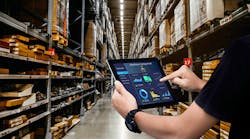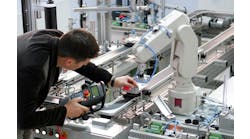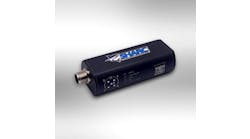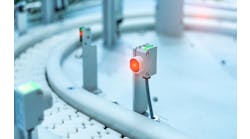Gerry Paci is market manager, material handling/AGVs, at Pepperl+Fuchs.
What sorts of sensing technologies have improved the effectiveness and reliability of picking systems and conveyance systems?
Gerry Paci, market manager, material handling/AGVs, Pepperl+Fuchs: As far as sensor technology is concerned, the possibilities are constantly evolving. In terms of picking and conveyance systems, there are several aspects of the process that need to be evaluated.
Also read: Warehouse automation with the human touch
Light detection and ranging (LiDAR), for example, is commonly used to profile boxes, poly bags and other contents on the conveyor while improving belt-utilization efficiency.
When it comes to the actual rollers, motor roller controllers can ensure zero pressure accumulation (ZPA). Stand-alone control units can save a lot of time in programming, setup and installation.
In addition, the ZPA system can be enhanced with detection and presence technology such as miniature photoelectric sensors.
Finally, the use of vision systems and/or 3D camera systems to assist in the selection of items to be picked and their placement can ensure that picking and conveyance systems operate smoothly.
As warehouse distribution centers continue to grow larger, how are tracking and intelligence helping to keep up with customer demands?
Gerry Paci, market manager, material handling/AGVs, Pepperl+Fuchs: In terms of tracking and tracing, RFID and barcode reading play an important role. From the moment an item is removed from a shelf or placed on a conveyor from the dock, barcode scanning and RFID tracking are critical.
With the addition of IO-Link technology, the ability to remotely monitor product locations over a single network and retrieve sensor health and status via diagnostic data becomes a requirement for meeting warehouse demand.
As demand grows exponentially, the need to manage large amounts of data is a key benefit of IO-Link, while saving time and cost.
Which technologies have allowed warehouses to increase throughput rates while expanding product ranges and still maintaining accurate order fulfillment?
Gerry Paci, market manager, material handling/AGVs, Pepperl+Fuchs: Many of the technologies used have been around for some time, but their use in new and unique ways combined with more advanced software, is leading to new methods. For example, collaboration between humans and automation has dramatically changed the picking process. Products can now be arranged and stored in different locations and in different ways, with humans doing the picking under the guidance of automation systems. Automated visors and glasses can provide hands-free guidance and work instructions. Pick-to-light systems also provide necessary visual indication, while RFID and barcode readers ensure accurate order picking. High-resolution LiDAR scanners can monitor large areas to ensure items are stored and picked in the correct location. These scanners can also monitor and provide feedback on conveyor-belt loading and utilization, which helps improve overall facility throughput. Finally, high-speed 3D vision sensors can provide accurate information on package dimensions to increase palletizing speed and performance.
Because of the warehouse’s physical nature, how much of the facility’s hardware can be replaced with software in order to facilitate easier upgrades, expansions and reconfigurations?
Gerry Paci, market manager, material handling/AGVs, Pepperl+Fuchs: Hardware is not being replaced by software, but it is evolving due to advances in software capabilities, such as artificial intelligence (AI), combined with advancements in sensing and tracking technologies. Large, rigid, inflexible systems are now being replaced by more modular storage systems that can be easily expanded as volume increases and additional storage is needed.
Improved software capabilities, for example, allow multi-directional shuttles to replace single-direction pickers, increasing system flexibility and boosting throughput as additional shuttles can be added to the system as volume needs increase. It is all about increased speed and flexibility. Hardware is not eliminated, but delays and lost time are.
How have automated storage and retrieval systems' roles changed over the past 10 years?
Gerry Paci, market manager, material handling/AGVs, Pepperl+Fuchs: While AS/RS used to be more common in larger warehouses and distribution centers, the AS/RS design criteria has changed due to changing consumer habits and the resulting need for smaller fulfillment methods, such as micro-fulfillment.
AS/RS has evolved into more modular form factors that are more easily adaptable to different layouts, such as in existing retail and food facilities, and also incorporates new technologies such as shuttle systems. The end result is that these systems are higher density, more versatile and easier to upgrade and have better performance than their older counterparts.
Will autonomous mobile robots replace automated guided vehicles altogether, or is there room for both, based on the application or complementary functions?
Gerry Paci, market manager, material handling/AGVs, Pepperl+Fuchs: AGVs use simpler navigation systems and follow predetermined paths, which makes them less costly to develop and easier to use in situations such as a moving production line. In contrast, AMRs use more complex navigation systems and can autonomously navigate through open spaces without having to follow a predetermined path. Ultimately, which system is best depends entirely on the requirements of the application. I believe there will continue to be a need for both types of capabilities, and both will continue to expand for the foreseeable future.






